Looking at the City’s Fiscal Forest
To start, we can take a look at overall performance, compared to last year’s budget projections.
Overall Picture and Projection Accuracy
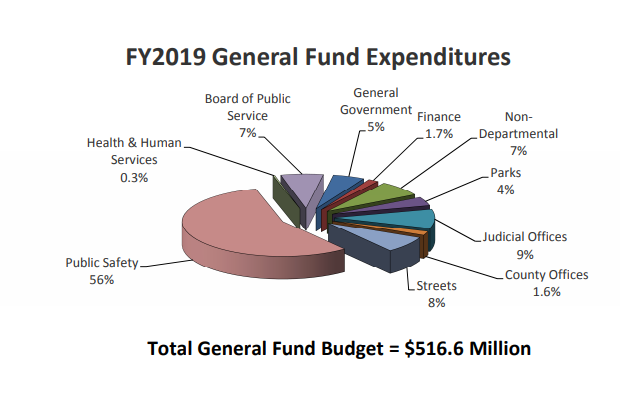
Spring has finally arrived in the Mound City, and it is time for another year’s budget negotiations to begin in earnest. This past Wednesday afternoon saw the budget (aka Annual Operating Plan or AOP)’s introduction at the board of Estimate and Apportionment. At the meeting, Budget Director Paul Payne walked E&A’s three members (Mayor, President of the Board and Comptroller) through the main points of this year’s proposed budget. A video of the meeting can be seen, here. At the meeting, we learned that while FY18 sales tax growth exceeded recent trends, other streams have failed to meet projections. This means that overall FY18 revenue is likely to fall slightly short of the original budget projections. While not given a side-by-side treatment in the document, we have put together to following table from this budget and last year’s document, in order for folks to see where we have performed well and where we overestimated. In addition to these General Fund dollars, the city also has an almost equal amount of revenue to city departments that come through dedicated tax streams and grants. The table below uses revenue projections from the FY18 budget document and the newly revised projections in the FY19 budget.
As you can see, the biggest negative miss comes in the form of the Earnings Tax estimate. After many years of growing faster than most other streams, it appears that we added less jobs than hoped, in the past year. This is further supported by the minuscule increase in Payroll Tax receipts. These receipts have been growing far slower than Earnings Tax, due to so many of the new jobs being created in our city’s nonprofit “Meds and Eds” ecosystem. Many of the city’s largest employers are nonprofits and exempt from paying Payroll Taxes. This leads to the situation where Earnings Tax receipts can miss the mark by almost $5 million and still grow by almost $3 million, while Payroll receipts can meet the estimate and only grow by less than $200,000.00.
There are a couple of other notable details that Budget Director Payne pointed out at the presentation.
- Franchise/Utility revenue growth is not indicative of strength in that stream. It is due to a settlement that the city received in lump sum. Long term trends in that stream remain unchanged.
- The deficit in intergovernmental receipts is substantially due to a delay in prisoner cost reimbursements from the state. These are expected to be paid in FY19 and budget projections reflect as much.

One should also note that the city’s total operating budget, including dedicated tax revenue has risen to $1,112.4M. This is roughly a 5% increase. This is largely due to the recent passage of increased Public Safety and Economic Development sales taxes.
Notes of Caution from Budget Division
While Dir. Payne stated that budget projections assume continued economic growth along the lines of recent years, he did note we are in an abnormally long expansion period and that the next recession is likely coming sooner than later. The biggest danger he noted is the same as we noted in our recent analysis of the city’s Comprehensive Annual Financial Report (CAFR): employee pensions stand to do incredible damage to the city’s annual budget and overall fiscal position, in the event of a significant downturn.
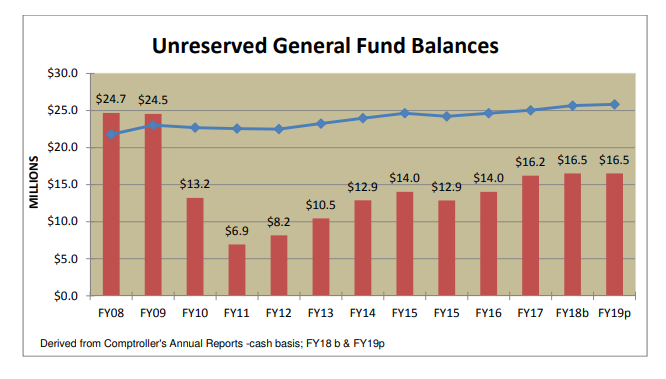
As you can see, the city’s Unreserved General Fund Balance (city’s emergency funds) stands steady at $16.5M.This is a bit below the $18.5M in reserves that the city was forced to spend during the previous economic downturn. Additionally, in the case of the previous downturn, city pensions were funded at or near 100%, whereas they are mostly now only funded at about 80%. This means that an economic downturn could lead to all of our city’s reserve funds going to keep the pensions at 80%, which is near the low end of what fund managers consider healthy.
As Dir. Payne stated the difficulty is that in the case of the stock market taking significant losses and decreased receipts from taxes, a government’s revenues begin falling at the exact same time that pension solvency obligations rapidly increase. This reality of economics creates a dangerous situation for local governments, including our own. With reserves already low and pensions likely to begin a potential downturn so close to financial danger, Dir. Payne’s analysis matches our concern about the fiscal health of the city’s pension obligations, which is in turn directly connected to the city’ declining Net Position.
Dir. Payne also warned to not get too excited about FY18 Sale Tax growth, as he expects the level to return to closer to recent years’ levels, which have been running closer to a 1% per annum increase.
To help increase reserves, Dir. Payne has recommended a new “Budget Reserve Initiative” in order to increase the budget reserves. As it stands, he says that a 5% budget reserve is the minimum a municipality should hold, while a 10% budget reserve is generally considered to be a better standard. As it stands, we are closer to a 3% reserve. This new initiative would place 1.5% of payroll into the reserve fund, which would be an estimated $3.4M in the coming year. The document says that “several million” in proceeds from the sale of the Municipal Courts buildings and other streams are also slated to be added to the city’s reserve fund.
A Walk Among the Trees
Now that we have taken a look at the overall picture, we will look at some notable changes that are deeper within the document. Some of these will have real implications for city services.
News about Use Tax Revenues
Few revenue streams have seen the amount of attention that the Use Tax has received, in recent years. Affordable housing advocates, including Team TIF, have joined the longstanding call to increase funds for the Affordable Housing Trust Fund (AHTF). To raise this money, the coalition has been advocating that half of the new monies (approximately $2M of close to $4M total) be sent to the AHTF. Advocates can now see that their requests have gone largely unfulfilled. While there is a modest increase in AHTF funding (~$700k), demolition ($1M) and the SLMPD (~$2.2M) receive the lion’s share. Additionally, other departments saw funding from Use Tax revenues zero’d out.
There are a few of other things to note in this particular revenue stream. The biggest one is that we now have an explanation as to where the new revenue from Amazon and other digital retailers is going, which is the Use Tax. This and other details are contained in Dir. Paynes’ note in the subsection.
Circuit Attorney’s Office Funding
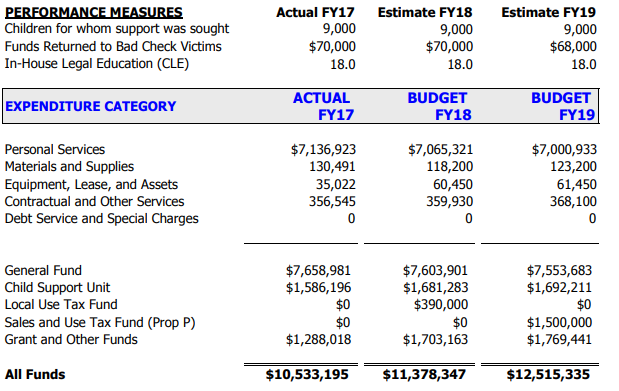 With the passage of Prop P, the Circuit Attorney’s Office (CAO) was promised a total of $1.5 Million in new revenue. While one can see that there is $1.5M dedicated to the office, via Prop P dollars, the office does not actually receive $1.5M in new total funding. The CAO is receiving over a million in new funds, though. As it stands, the CAO is slated to receive $363,012.00 below the full $1.5M increase in total funding that voters may have expected. We will point out that this is very close to the $390,000.00 lost in Use Tax funds, per the prior section. While much was made about the new dollars being an “ironclad” promise, the truth of budgeting is far more complicated. This serves as a good example of how one can keep to the letter of a promise, while still failing to uphold the spirit. With a local government is such poor financial shape, these kinds of trade offs are extremely common.
With the passage of Prop P, the Circuit Attorney’s Office (CAO) was promised a total of $1.5 Million in new revenue. While one can see that there is $1.5M dedicated to the office, via Prop P dollars, the office does not actually receive $1.5M in new total funding. The CAO is receiving over a million in new funds, though. As it stands, the CAO is slated to receive $363,012.00 below the full $1.5M increase in total funding that voters may have expected. We will point out that this is very close to the $390,000.00 lost in Use Tax funds, per the prior section. While much was made about the new dollars being an “ironclad” promise, the truth of budgeting is far more complicated. This serves as a good example of how one can keep to the letter of a promise, while still failing to uphold the spirit. With a local government is such poor financial shape, these kinds of trade offs are extremely common.
Economic Development Tax Revenue
The fate of the “EcoDevo” sales tax revenue remains a mystery. Little to no detail is given, outside of how much has been collected. We do know that a significant portion is backing the upcoming “no tax increase” bond issue to pay for capital needs.

This is unlikely to assuage fears of voters who believe the money will be spent on items that differ from what voters were told to expect, during the campaign supporting passage.
Hotel Receipts Cooling as Market Prepares to Expand Capacity
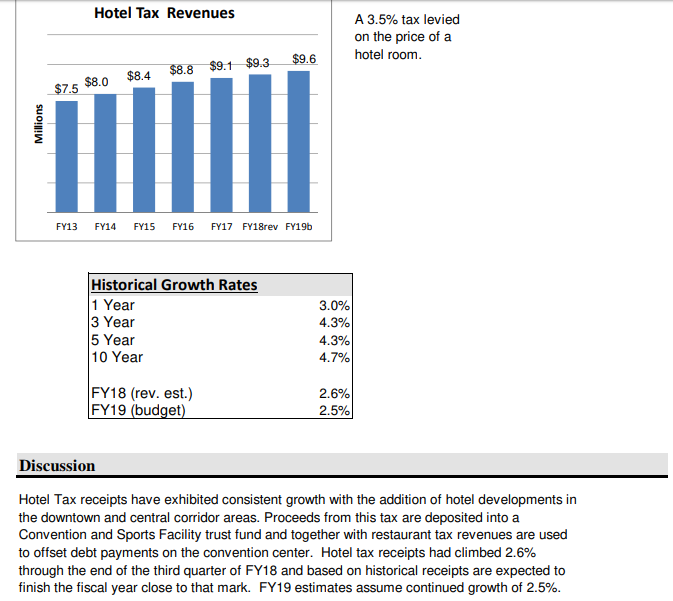
One area that Team TIF has repeatedly called for increased caution is in the granting of tax incentives to drive the building of hotels in Central Corridor. The city’s hotel industry has had its ups and downs and we have continued to question the wisdom of bringing so much new, non-union capacity into the market, in a relatively short period of time. This year’s budget document reinforces some of those questions.
As you can see, hotel receipt growth has essential slowed to a rate far closer to that of inflation, while recent years had seen much faster growth. This could be indicative of a market whose demand growth is slowing. While this could be due to restricted supply, there are not a lot of indications that this is the case. More likely, demand has steadied and per night rate increases are leveling out. Many new hotels are slated to soon come to market, with almost all receiving various tax incentives, including TIF. This is the danger of the substitution effect that Team TIF has warned about. As it stands, it is possible that these newly built hotels will reduce demand at existing, tax paying hotels and further slow or even reverse this revenue stream’s growth.
Public Safety Funding Changes
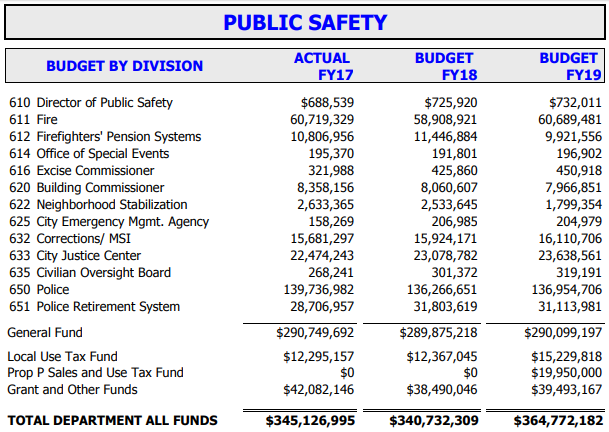 Overwhelmingly, the funding increases found in the city’s Public Safety budget come from two sources: revenue from the two new sales taxes and reduced pension costs, largely driven by the extremely strong stock market performance of the last year. It should be noted that this savings in pension costs comes at the expense of attempting to further reduce our unfunded pension obligations.
Overwhelmingly, the funding increases found in the city’s Public Safety budget come from two sources: revenue from the two new sales taxes and reduced pension costs, largely driven by the extremely strong stock market performance of the last year. It should be noted that this savings in pension costs comes at the expense of attempting to further reduce our unfunded pension obligations.
The other notable change is that the Neighborhood Stabilization Officers (NSO) / Neighborhood Improvement Specialist (NIS) job will see a reduction of half the staff. The city will reduce this position from 24 to 12 positions and align these positions more with the city’s six police districts, instead of the traditional ward designations. This is likely the first of reforms meant to prepare the city for a change in how business is done, leading into the upcoming reduction in wards. While this aligns with the goal of removing the alderpeople from the city’s service request system, it doesn’t address where the labor hours currently given by the alderpeople will be made up, and, additionally, this reduction in positions means a further reduction of labor hours dedicated to providing assistance with the public’s needs. If this is made up somewhere else in the budget, it is not made clear. This reduction in staffing was prompted by the end of a SAFER grant that provided similar amounts of funding to the Fire Department. These dollars are being shifted to the Fire Department to cover those lost funds and provide continuity of Fire Department funding/service.
Concealed Carry Permit Issuance Continues Low Numbers
As an aside, the report notes a continuing trend in the reduction of concealed carry permits issued by the Sheriff’s office. It is unclear why, but likely due to changes at the state level that have drastically liberalized gun laws in Missouri.
Construction Activity is High
As expected, construction activity is high in the city, and, in FY17, with rehabs of buildings costing over $500,000.00 leading the way. With so many large TIF’d and abated projects approved, this should be of no surprise. New construction over $500,000.00 saw a significant decline, though one could expect that to reverse in this coming year. Rehabs climbed higher, while new housing starts were down. Overall, this year’s budget document FY18 appears to show a large increase in permit-driven revenue. We should expect that to be reflected in FY18 construction values, when finally tallied and published, and those should significantly top FY17 numbers shown in these graphs.
As the graph to the left shows, the overwhelming majority of the increases in construction activity is in rehabbed commercial construction projects.
Good news for SLATE
SLATE has landed a sizable increase in grant funding, improving the city’s job training budget, significantly. A rare highlight in FY19 social service funding increases. In a city with significant job training needs, this is welcome news.
Community Development/Service Funding News
This is a decidedly mixed bag. On one had, the alders are now receiving their full shares of “Ward Capital” monies, after previous cuts to the program. This increased funding will allow alderpeople to make hyper-local budgeting decisions, though some complain that these discretionary dollars are sometimes misspent. This money is coming from reduced citywide capital costs. Likewise, Prop P will allow full funding to the city’s recreation centers, after under funding in recent years.
On the other hand, almost all of the projected Community Development Administration office’s budget increase is going to increased debt service and special charges. As mentioned earlier, this continues to add to the question of where EcoDevo sales tax revenue is going. While it may be apparent in the more detailed line item budget documents, it is hard to locate in this section of the budget. During the campaign for passage, there was a program touted that would increase support to communities wishing to do neighborhood redevelopment plans. We hope that this promise is kept and that voters will receive the community development planning assistance that they need and were promised.
Labor Force Change Analysis
The city continues to attract higher income jobs, but has lost total wages. This is evidenced by increasing average wages and incomes, while total wages and positions declined. Falling civilian labor force numbers continue to align relative to the city’s continuing population loss estimates.
Credit Rating Situation for City Remains Precarious
As you can see, the city’s credit ratings remain less than optimal. Unless our fiscal position improves, we are likely to see further downgrades, in the event of a large economic downturn leading to further erosion the city’s overall fiscal picture.
Stepping Back to Again See The Forest
As stated at the beginning, there aren’t a lot of major changes in the city’s fiscal picture. Overall, the report is indicative of a city that is still struggling to gain financial footing, though is treading water. It is difficult to know how some of the changes will be received. Will the increase in Ward Capital monies assuage neighbor anger over the reduction in NSO positions/service? Will said reduction actually help move the alders out of the equation or simply drive even more calls to the elected officials, as residents now have fewer mediaries between themselves and CSB? It is impossible to know.
In the end, we are essentially left with Dir. Payne’s warnings of a city that is poorly positioned to withstand a major economic downturn, though new sales tax streams have taken some of the pressure off of the General Fund. As it stands, we have around 2/3rds of the reserve fund that the city held, when the last downturn occured. Compounding the reduced size of the city’s “rainy day” fund is that our pension obligation funding never recovered to pre-recession levels, leaving us in a position to have to spend significant amounts of our reserve fund and/or general fund revenue during the next economic downturn, even if it is relatively mild compared to the most recent recession.